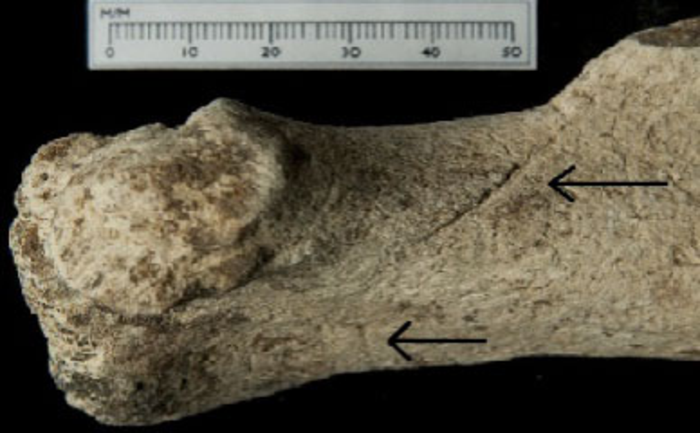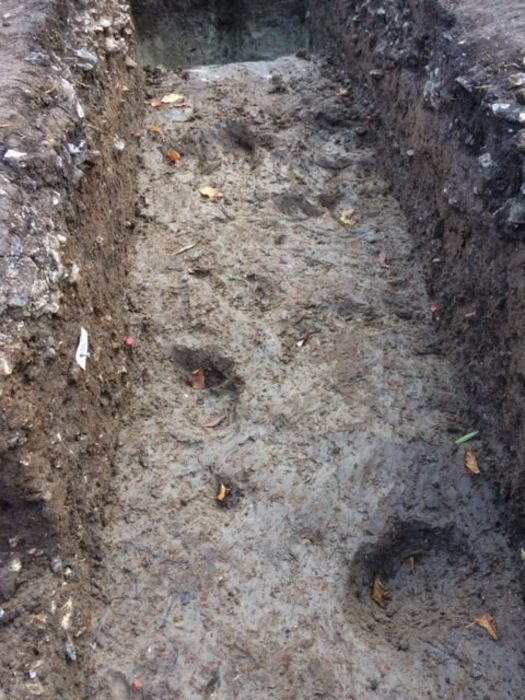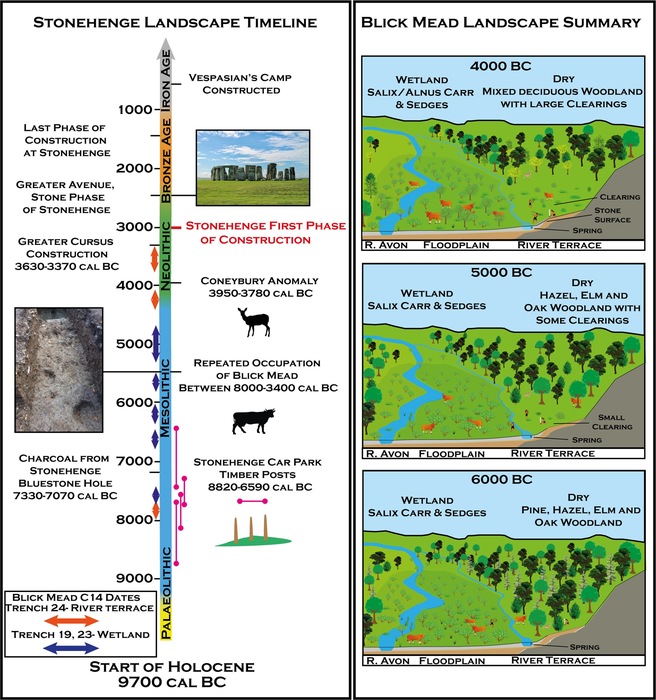Stonehenge landscape, Blick Mead, during the Mesolithic period
Study reveals Stonehenge landscape before the world-famous monument
Four thousand years before Stonehenge was constructed, land within the World Heritage Site was covered by open woodland, with meadow-like clearings, inhabited by grazing animals and hunter-gatherers, according to new research by the University of Southampton.
Scientists exploring Blick Mead, a Mesolithic archaeological site within a chalkland spring area about a mile from the iconic standing-stones, have found evidence the land was not covered in dense, closed canopy forests during the later Mesolithic period, as had previously been thought. Rather, it was partially wooded and populated by aurochs (cattle), red deer, elk and wild boar – making it good hunting ground for humans who lived opportunistically off the land, prior to the arrival of early farmers.

Lead researcher, Samuel Hudson, of Geography and Environmental Science at Southampton explains: “There has been intensive study of the Bronze Age and Neolithic history of the Stonehenge landscape, but less is known about earlier periods. The integration of evidence recovered from previous excavations at Blick Mead, coupled with our own fieldwork, allowed us to understand more about the flora and fauna of the landscape prior to construction of the later world-famous monument complex.
“Past theories suggest the area was thickly wooded and cleared in later periods for farming and monument building. However, our research points to pre-Neolithic, hunting-gatherer inhabitants, living in open woodland which supported aurochs and other grazing herbivores.”

The research team analysed pollen, fungal spores and traces of DNA preserved in ancient sediment (sedaDNA), combined with optically stimulated luminescence (OSL) and radiocarbon dating to produce an environmental history of the site. Using this evidence, they built a picture of the habitat in the area from the later Mesolithic (5500 BC) to the Neolithic period (from 4,000 BC).
The study indicates that later Mesolithic populations at Blick Mead took advantage of more open conditions to repeatedly exploit groups of large ungulates (hoofed mammals), until a transition to farmers and monument-builders took place. In a sense, the land was pre-adapted for the later large-scale monument building, as it did not require clearance of woodland, due to the presence of these pre-existing open habitats. The researchers suggest there was continuity between the inhabitants of the two eras, who utilised the land in different ways, but understood it to be a favourable location.
The findings of the team from Southampton, working with colleagues at the universities of Buckingham, Tromsø and Salzburg, are published in the journal PLOS ONE.
The scientists plan further exploration of the Mesolithic history of this area, which they hope to begin at the end of this year.
Press release from the University of Southampton
———————————————————————————————————————————————————-
Before Stonehenge monuments, hunter-gatherers made use of open habitats
Study investigates habitat conditions encountered by first farmers and monument-builders

Hunter-gatherers made use of open woodland conditions in the millennia before Stonehenge monuments were built, according to a study published April 27, 2022 in the open-access journal PLOS ONE by Samuel Hudson of the University of Southampton, U.K., and colleagues.
Much research has explored Bronze Age and Neolithic history of the region surrounding Stonehenge, but less is known about earlier times in this area. This leaves open questions about how ancient people and wildlife used this region before the famous archaeological monuments were constructed. In this paper, Hudson and colleagues reconstruct environmental conditions at the site of Blick Mead, a pre-Neolithic hunter-gatherer site on the edge of the Stonehenge World Heritage Site.
The authors combine pollen, spores, sedimentary DNA, and animal remains to characterize the pre-Neolithic habitat of the site, inferring partially open woodland conditions, which would have been beneficial to large grazing herbivores like aurochs, as well as hunter-gatherer communities. This study supports previous evidence that the Stonehenge region was not covered in closed canopy forest at this time, as has previously been proposed.
This study also provides date estimates for human activity at Blick Mead. Results indicate that hunter-gatherers used this site for 4,000 years up until the time of the earliest known farmers and monument-builders in the region, who would also have benefited from the space provided in open environments. These results indicate that the first farmers and monument-builders in the Stonehenge area encountered open habitats already maintained and used by large grazers and earlier human populations.
Further study on similar sites will provide important insights into the interactions between hunter-gatherers and early farming communities in the U.K. and elsewhere. Furthermore, this study provides techniques for combining sedimentary DNA, other ecological data, and stratigraphic data to interpret the ancient environment at a site where such information is difficult to assess.
The authors add: “The Stonehenge World Heritage Site is globally recognized for its rich Neolithic and Bronze Age monumental landscape, but little is known of its significance to Mesolithic populations. Environmental research at Blick Mead suggests that hunter-gatherers had already chosen part of this landscape, an alluvial clearing, as a persistent place for hunting and occupation.”
Citation: Hudson SM, Pears B, Jacques D, Fonville T, Hughes P, Alsos I, et al. (2022) Life before Stonehenge: The hunter-gatherer occupation and environment of Blick Mead revealed by sedaDNA, pollen and spores. PLoS ONE 17(4): e0266789. https://doi.org/10.1371/journal.pone.0266789
Author Countries: U.K., Norway, Austria
Funding: The authors received no specific funding for this work. However, the corresponding author did receive funding from the University of Southampton for general fieldwork costs.
Press release from the Public Library of Science


